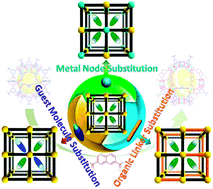Substitution reactions in metal–organic frameworks and metal–organic polyhedra
Abstract
Substitution reaction, as one of the most powerful and efficient chemical reactions, has been widely used in various syntheses, including those for the design and preparation of functional molecules or materials. In the past decade, a class of newly developed inorganic–organic hybrid materials, namely metal–organic materials (MOMs), has experienced a rapid development. MOMs are composed of metal-containing nodes connected by organic linkers through strong chemical bonds, and can be divided into metal–organic frameworks (MOFs) and metal–organic polygons/polyhedra (MOPs) with infinite and discrete structural features, respectively. Recent research has shown that the substitution reaction can be used as a new strategy in the synthesis and modification of MOFs and MOPs, particularly for pre-designed ones with desired structures and functions, which are usually difficult to access by a direct one-pot self-assembly synthetic approach. This review highlights the implementation of the substitution reaction in MOFs and MOPs. Examples of substitution reactions at metal ions, organic ligands, and free guest molecules of MOFs and MOPs are listed and analyzed. The changes or modifications in the structures and/or properties of these materials induced by the substitutions, as well as the nature of the associated reaction, are discussed, with the conclusion that the substitution reaction is really feasible and powerful in synthesizing and tailoring MOMs.

- This article is part of the themed collection: Metal Organic Frameworks (MOFs)

 Please wait while we load your content...
Please wait while we load your content...